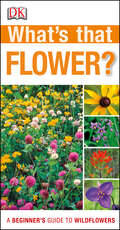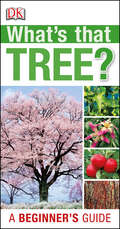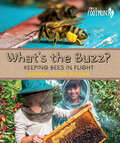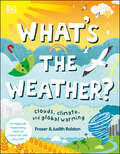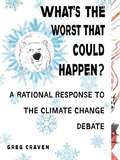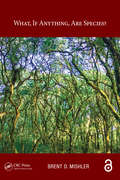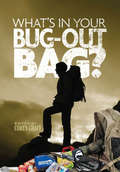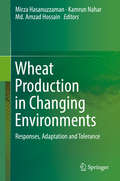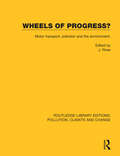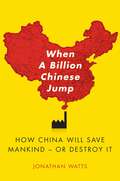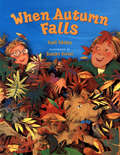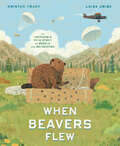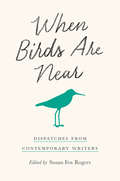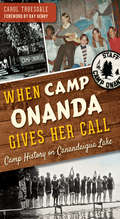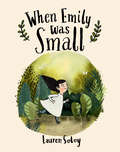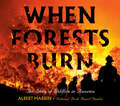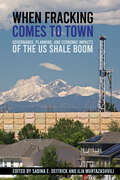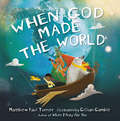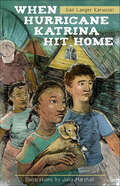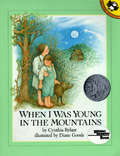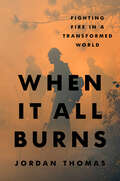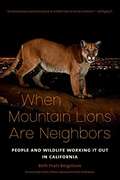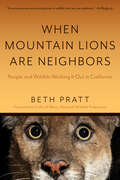- Table View
- List View
What's that Flower?: A Beginner's Guide to Wildflowers (DK What's That?)
by DKStop and smell the roses with this delightful flower spotter guide.Know your geraniums from your pansies! This beautiful flower identification book features over 150 flower species found east of the Mississippi along with a simple, visual approach to help you tell them apart with absolute ease.With its compact, portable format, this nature book is designed for ease of use anywhere — ideal for nature lovers everywhere. Here&’s what&’s inside: • Similar flower species are shown together for quick comparison and identification • Fully-illustrated introductions explain the basics of flower identification — what to look for and how to tell the difference between similar wildflower species or specimens • Overview pages on main features give readers more detailed information on how to make an accurate identification • The at-a-glance finder section at the back shows thumbnails of the species grouped in an intuitive way for ease of reference Calling all flower enthusiasts! Are you interested in identifying the wildflowers you encounter on your walks along the coast or in the mountains, woodlands or fields? Look no further than What's That Flower? Authoritative text, beautiful photographs and detailed illustrations show different parts of the flower — from the stem to the petals. Flower type overviews show you what to look for where and similar flowers are shown side by side for quick comparison and identification. It's the perfect flower encyclopedia for beginners, but also a handy reference guide for the more seasoned flower lovers.
What's that Tree?: A Beginner's Guide (DK What's That?)
by DKLearn more about the beautiful trees around you with this identification guide, perfect for beginners, featuring over 150 common tree species. If you want to know the difference between a Serbian spruce and a silver birch or how different trees change through the seasons then What&’s that Tree? is the ideal guide for you. Species overviews show you what to look for where and related trees are shown side by side for quick comparison and identification.Clear photography of leaves will help you to directly compare the tree you&’re looking at with those in the guide and will assist you with specific features of the leaf to help identify the tree. This quick-reference guide also includes information on bark, flowers, and seeds. The perfect pocket guide for beginners but also a handy reference for the more seasoned naturalist, What&’s that Tree? will help you to become an expert tree-spotter in no time.
What's the Buzz?: Keeping Bees in Flight (Orca Footprints #7)
by Merrie-Ellen WilcoxWhether they live alone or together, in a hive or in a hole in the ground, bees do some of the most important work on the planet: pollinating plants. What's the Buzz? celebrates the magic of bees--from swarming to dancing to making honey--and encourages readers to do their part to keep the hives alive. All over the world, bee colonies are dwindling, but everyone can do something to help save the bees, from buying local honey to growing a bee-friendly garden.
What's the Weather?: Clouds, Climate, and Global Warming (Protect the Planet)
by Fraser Ralston Judith RalstonDiscover the science behind wild and wonderful weather in this fact-packed book!From heatwaves and big freezes to tornadoes and fog, this science book gives your budding meteorologist a glimpse into all the action that happens in the sky. Learn about all kinds of weather and marvel at how powerful it can be!At a time when extreme weather is becoming more and more common, this eco-focused book is perfect for getting your little one clued up about the environment. Throughout the pages of this colorful and energetic STEM book, your child will discover fun facts about the weather. They will also gain insight into serious topics such as global warming and how our climate is changing.Inside the pages of this beautifully illustrated children's science book, you'll learn all about the weather, and discover:- Fascinating illustrations that introduce scientific topics in a simple and accessible way - Stand out facts, presented clearly on each spread- Easy to understand text that teach children about climate change, meteorology, and geography- Bright photos and stunning illustrations that show how weather forms, what's going on inside clouds, and why we have heatwavesThe easy-to-follow text and bite-sized facts will keep young climate activists engaged and inspire them to do whatever they can to turn things around and fight climate change!Become a Weather Expert in No TimeThis educational science book tells a riveting story about how big, amazing, and wonderful our weather really is - but it's told from the child's perspective. The book itself has also been produced as sustainably as possible, made with responsibly sourced materials and soy inks. It's the perfect gift for environmentally conscious kids aged 7-9.
What's the Worst That Could Happen?
by Greg Craven6. 5 million YouTube viewers can't be wrong: A provocative new way to look at the global warming debate. Based on a series of viral videos that have garnered more than 6. 5 million views, this visually appealing book gives readers-be they global warming activists, soccer moms, or Nascar dads-a way to decide on the best course of action, by asking them to consider, "What's the worst that could happen?" And for those who decide that action is needed, Craven provides a solution that is not only powerful but also happens to be stunningly easy. Not just another "change your light bulb" book, this intriguing and provocative guide is the first to help readers make sense-for themselves-of the contradictory statements about global climate change. The globe is warming! or The globe is not warming. We're the ones doing it! or It's a natural cycle. It's gonna be a catastrophe! or It'll be harmless. This is the biggest threat to humankind! or This is the biggest hoax in history.
What, if anything, are species? (Species and Systematics)
by Brent D. MishlerThis book is an extended argument for abandoning the species rank. Instead, the author proposes that the rank of "species" be replaced by a pluralistic and multi-level view. In such a view, all clades including the smallest identifiable one would be named and studied within a phylogenetic context. What are currently called "species" represent different sorts of things depending on the sort of organisms and processes being considered. This is already the case, but is not formally recognized by those scientists using the species rank in their work. Adopting a rankless taxonomy at all levels would enhance academic studies of evolution and ecology and yield practical benefits in areas of public concern such as conservation. The Open Access version of this book, available at http://www.taylorfrancis.com/books/e/9781498714549, has been made available under a Creative Commons Attribution-Non Commercial license. KEY FEATURES • Proposes the replacement of restrictive species concepts with a pluralistic view • Suggests abandoning the formal taxonomic rank of "species" • Considers zoological, botanical, and microbiological aspects of the species level • Deals with practical issues such as conservation, inventories, and field guides
What’s in Your Bug Out Bag?: Survival kits and bug out bags of everyday people. (Survival & Preparedness)
by Corey GraffIn What's In Your Bug Out Bag?, you'll hear from 15 everyday people as they describe their actual bug out bag list - the ultimate 72-hour go-kit guide from and for real people. Get survival kit ideas and find out what first aid, shelter, navigation, food, water and personal protection items people are counting on to get to safety. Each bug out bag checklist is described and analyzed by our expert staff plus in the words of the people who assembled these bug out bags. If you're wondering how to make a survival kit or how to make a bug out bag you've come to the right place.In What's In Your Bug Out Bag? You'll Learn:Popular gear for bugging out and preppingHow to choose the best backpacks for bug out bagsHow to organize and prioritize gear for your bug out bag
Wheat Production in Changing Environments: Responses, Adaptation and Tolerance
by Mirza Hasanuzzaman Kamrun Nahar Md. Amzad HossainThis book presents recent advances in global wheat crop research, including the effects of abiotic stresses like high and low temperatures, drought, hypoxia, salinity, heavy metals, nutrient deficiency, and toxicity on wheat production. It also highlights various approaches to alleviate the damaging effects of abiotic stress on wheat as well as advanced approaches to develop abiotic-stress-tolerant wheat crops. Wheat is probably one of the world’s most important cereals; it is a staple food in more than 40 countries, and because of its adaptability is cultivated in almost every region. Global wheat production has more than doubled in the last 50 years due to higher yields. However, despite their high yield potential, modern wheat cultivars are often subject to crop loss due to the abiotic stresses. As such, plant breeders have long aimed to improve tolerance in order to maintain yield. Written by 85 experts, and offering the latest insights into wheat responses and tolerance to various abiotic stresses, it is a valuable tool for agronomists, plant breeders, plant physiologists and students in the field of plant science and agriculture. It is the first book to comprehensively cover past and current abiotic stress problems and tolerance mechanisms.
Wheels of Progress?: Motor transport, pollution and the environment.
by J. RoseOriginally published in 1973 and based on papers published in The International Journal of Environmental Studies, this book discusses the impact of road vehicles on the environment. Particular stress is laid on the design of towns and vehicles, economic problems associated with these, the responsibility of planners and the integration of transport planning and environmental planning at local, regional and national levels. Subsequent sections cover the science of accident research and legislation, particularly dealing with global pollution control. Many of the problems discussed remain as pressing today as when this book was first published.
When A Billion Chinese Jump: How China Will Save Mankind -- Or Destroy It
by Jonathan S. WattsAs a young child, Jonathan Watts believed if everyone in China jumped at the same time, the earth would be shaken off its axis, annihilating mankind. Now, more than thirty years later, as a correspondent for The Guardian in Beijing, he has discovered it is not only foolish little boys who dread a planet-shaking leap by the world’s most populous nation. When a Billion Chinese Jump is a road journey into the future of our species. Traveling from the mountains of Tibet to the deserts of Inner Mongolia via the Silk Road, tiger farms, cancer villages, weather-modifying bases, and eco-cities, Watts chronicles the environmental impact of economic growth with a series of gripping stories from the country on the front line of global development. He talks to nomads and philosophers, entrepreneurs and scientists, rural farmers and urban consumers, examining how individuals are trying to adapt to one of the most spectacular bursts of change in human history, then poses a question that will affect all of our lives: Can China find a new way forward or is this giant nation doomed to magnify the mistakes that have already taken humanity to the brink of disaster?
When Autumn Falls
by Susan Swan Kelli NideyAs September fades, a new season begins. Leaves and temperatures tumble. And, as autumn falls, new colors and smells gradually replace the heat and intensity that was summer. Children love caramel-apple making and bobbing for apples. Jack-o'-lanterns appear and piles of leaves stacked high beckon. Autumn means the end of summer, but the beginning of something new and crisp and familiar.
When Beavers Flew: An Incredible True Story of Rescue and Relocation
by Kristen TracyThis fascinating picture book tells the unique, quirky, and true story of how one man in Idaho saved 76 beavers from destroying a town by parachuting them into uninhabited wetlands.In 1948, the town of McCall, Idaho was growing rapidly. World War II was over, and the little town tucked away in the mountains began to boom. There was only one problem. As the town expanded, they found beavers everywhere. A beaver here, a beaver there, and it didn&’t take long to realize that humans and beavers weren&’t great cohabitators. But one clever and resourceful Fish and Game Warden named Elmo Heter had an idea.Heter knew that the beavers were integral to the wetlands, so keeping the well-being of the beavers in mind he set out to find a way to relocate them. After a few failed attempts, he finally landed on a wild idea… parachutes. Using a surplus of parachutes left over from WWII and creating a special box with air holes designed to pop open when it hit the ground, Heter devised a way to parachute the beavers into Idaho&’s backcountry, an area that beavers hadn&’t inhabited in decades.Kirsten Tracy&’s fascinating and playful nonfiction text pairs beautifully with Luisa Uribe&’s detailed illustrations to bring this compelling true story to life.
When Birds Are Near: Dispatches from Contemporary Writers
In this dazzling literary collection, writers explore and celebrate their lives with and love for birds—detailing experiences from Alaska to Bermuda, South Dakota to Panama. In When Birds Are Near, fresh new voices as well as seasoned authors offer tales of adventure, perseverance, and fun, whether taking us on a journey down Highway 1 to see a rare California Condor, fighting the destruction of our grasslands, or simply watching the feeder from a kitchen window.But these essays are more than just field notes. The authors reflect on love, loss, and family, engaging a broad array of emotions, from wonder to amusement. As Rob Nixon writes, "Sometimes the best bird experiences are defined less by a rare sighting than by a quality of presence, some sense of overall occasion that sets in motion memories of a particular landscape, a particular light, a particular choral effect, a particular hiking partner." Or, as the poet Elizabeth Bradfield remarks, "We resonate with certain animals, I believe, because they are a physical embodiment of an answer we are seeking. A sense of ourselves in the world that is nearly inexpressible." When Birds Are Near gives us the chance to walk alongside these avid appreciators of birds and reflect on our own interactions with our winged companions.Contributors: Christina Baal, Thomas Bancroft, K. Bannerman, R. A. Behrstock, Richard Bohannon, Elizabeth Bradfield, Christine Byl, Susan Cerulean, Sara Crosby, Jenn Dean, Rachel Dickinson, Katie Fallon, Jonathan Franzen, Andrew Furman, Tim Gallagher, David Gessner, Renata Golden, Ursula Murray Husted, Eli J. Knapp, Donald Kroodsma, J. Drew Lanham, John R. Nelson, Rob Nixon, Jonathan Rosen, Alison Townsend, Alison Világ
When Camp Onanda Gives Her Call: Camp History on Canandaigua Lake
by Ray Henry Carol TruesdaleIn 1883, eleven Rochester women formed the Young Women's Association, and in 1919 they purchased Camp Onanda to provide an escape for young factory girls. The YWCA carried on that mission into the 1980s so that girls from all walks of life could experience the joys of camp. Over the decades, girls enjoyed summer activities like archery and sailing, drinking "bug juice" around the campfire and swimming lessons. They came from all over to experience the great outdoors, free from the economic hardships and social challenges of city life. In the spirit of that tradition, Onanda is now a beloved public park. Former Onanda counselor Carol Truesdale tells the story of Camp Onanda and of the many lives this camp changed.
When Emily Was Small
by Lauren SoloyA joyful frolic through the garden helps a little girl feel powerful in this beautiful picture book that celebrates nature, inspired by the writings of revered artist Emily Carr.Emily feels small. Small when her mother tells her not to get her dress dirty, small when she's told to sit up straight, small when she has to sit still in school. But when she's in the garden, she becomes Small: a wild, fearless, curious and passionate soul, communing with nature and feeling one with herself. She knows there are secrets to be unlocked in nature, and she yearns to discover the mysteries before she has to go back to being small . . . for now. When Emily Was Small is at once a celebration of freedom, a playful romp through the garden and a contemplation of the mysteries of nature.
When Forests Burn: The Story of Wildfire in America
by Albert MarrinA fascinating look at the most destructive wildfires in American history, the impact of climate change, and what we're doing right and wrong to manage forest fire, from a National Book Award finalist. Perfect for young fans of disaster stories and national history.Wildfires have been part of the American landscape for thousands of years. Forests need fire--it's as necessary to their well-being as soil and sunlight. But some fires burn out of control, destroying everything and everyone in their path. In this book, you'll find out about:how and why wildfires happenhow different groups, from Native Americans to colonists, from conservationists to modern industrialists, have managed forests and firethe biggest wildfires in American history--how they began and dramatic stories of both rescue and tragedywhat we're doing today to fight forest firesChock full of dramatic stories, fascinating facts, and compelling photos, When Forests Burn teaches us about the past--and shows a better way forward in the future.
When Fracking Comes to Town: Governance, Planning, and Economic Impacts of the US Shale Boom
When Fracking Comes to Town traces the response of local communities to the shale gas revolution. Rather than cast communities as powerless to respond to oil and gas companies and their landmen, it shows that communities have adapted their local rules and regulations to meet the novel challenges accompanying unconventional gas extraction through fracking. The multidisciplinary perspectives of this volume's essays tie together insights from planners, legal scholars, political scientists, and economists. What emerges is a more nuanced perspective of shale gas development and its impacts on municipalities and residents. Unlike many political debates that cast fracking in black-and-white terms, this book's contributors embrace the complexity of local responses to fracking. States adapted legal institutions to meet the new challenges posed by this energy extraction process while under-resourced municipal officials and local planning offices found creative ways to alleviate pressure on local infrastructure and reduce harmful effects of fracking on the environment. The essays in When Fracking Comes to Town tell a story of community resilience with the rise and decline of shale gas production. Contributors: Ennio Piano, Ann M. Eisenberg, Pamela A. Mischen, Joseph T. Palka, Jr., Adelyn Hall, Carla Chifos, Teresa Córdova, Rebecca Matsco, Anna C. Osland, Carolyn G. Loh, Gavin Roberts, Sandeep Kumar Rangaraju, Frederick Tannery, Larry McCarthy, Erik R. Pages, Mark C. White, Martin Romitti, Nicholas G. McClure, Ion Simonides, Jeremy G. Weber, Max Harleman, Heidi Gorovitz Robertson
When God Made the World
by Matthew Paul TurnerFrom the author of the bestselling children's book When God Made You comes a rhythmic, whimsical journey through creation--for little readers who love science and wonder and the beginnings of all things.For spiritual parents who are looking for a different kind of creation book, Matthew Paul Turner's When God Made the World focuses on the complex way that God created our vast and scientifically operating universe, including the biodiversity of life on our planet and the intricacies of a vast solar system. Scottish illustrator Gillian Gamble brings the natural world to vibrant life with rich colors and poignant detail certain to stretch young minds and engage imaginations.Planet Earth, God made a blue and green sphere,And designed it to orbit the sun once a year.God made daytime and nighttime, climates and seasons,And all kinds of weather that vary by region.God made continents and oceans, islands and seas,A north and south pole that God put in deep freeze.God carved rivers and brooks, mountains and caves,Made beaches with sand and huge crashing waves.God made tropics and plateaus, glaciers and meadows,marshes and tundras and erupting volcanos.
When Hurricane Katrina Hit Home
by Gail Langer KarwoskiChazz Cohen lives with his grandmom in the Garden District of New Orleans. In his family, money is no problem. But money won't buy Chazz what he wants--a "real" home with his mom. Across town in the Ninth Ward, Lyric Talbert wishes her mom didn't expect so much from her, especially when her little brother gets sick. It seemed like the storm would blow over as so many had. But Katrina burst the levees, and the world turned to chaos for Chazz and Lyric and their families. They quickly learn that, though their worlds were different before the storm, it was their courage and compassion that would help them make it through. Through the alternating stories of Chazz and Lyric, acclaimed children's author Gail Langer Karwoski chronicles the disaster that forever changed New Orleans and its people.
When I was Young in the Mountains
by Cynthia RylantA story about the childhood reminiscences of growing up in the Appalachian Mountains & the pleasures in life.
When It All Burns: Fighting Fire in a Transformed World
by Jordan ThomasA hotshot firefighter&’s gripping firsthand account of a record-setting fire seasonEighteen of California&’s largest wildfires on record have burned in the past two decades. Scientists recently invented the term &“megafire&” to describe wildfires that behave in ways that would have been nearly impossible just a generation ago, burning through winter, exploding in the night, and devastating landscapes historically impervious to incendiary destruction.In When It All Burns, wildland firefighter and anthropologist Jordan Thomas recounts a single, brutal six-month fire season with the Los Padres Hotshots—the special forces of America&’s firefighters. Being a hotshot is among the most difficult jobs on earth. Thomas viscerally renders his crew&’s attempts to battle flames that are often too destructive to contain. He uncovers the hidden cultural history of megafires, revealing how humanity&’s symbiotic relationship with wildfire became a war—and what can be done to change it back. Thomas weaves ecology and the history of Indigenous peoples' oppression, federal forestry, and the growth of the fire industrial complex into a riveting narrative about a new phase in the climate crisis. It's an immersive story of community in the most perilous of circumstances, told with humor, humility, and affection.
When Mountain Lions Are Neighbors: People and Wildlife Working It Out in California
by Beth Pratt-Bergstrom“This delightful book details our ever-evolving relationship with Earth’s wildest creatures, promising that peaceful coexistence is possible.” —Jennifer Holland, New York Times–bestselling authorWildness beats in the heart of California’s urban areas. In Los Angeles, residents are rallying to build one of the largest wildlife crossings in the world because of the plight of one lonely mountain lion named P-22. Porpoises cavort in San Francisco Bay again because of a grassroots effort to clean up a waterway that was once a toxic mess. And on the Facebook campus in Silicon Valley, Mark Zuckerberg and his staff have provided a home for an endearing family of wild gray foxes. Through actions as sweeping as citizen science initiatives and as instantaneous as social media posts, a movement of diverse individuals and communities is taking action to recast nature as an integral part of our everyday lives. When Mountain Lions Are Neighbors explores this evolving dynamic between humans and animals, including remarkable stories like the journey of the wolf OR-7 and how Californians are welcoming wolves back to the state after a ninety-year absence, how park staff and millions of visitors rallied to keep Yosemite’s famed bears wild, and many more tales from across the state. Written by Beth Pratt-Bergstrom of the National Wildlife Federation, these inspiring stories celebrate a new paradigm for wildlife conservation: coexistence.“A contemporary and exciting view of conservation that we all can celebrate.” —Ed Begley Jr.“When Mountain Lions Are Neighbors focuses on a serious problem by presenting meaningful solutions, and is as enjoyable to read as it is informative.” —Foreword Reviews
When Mountain Lions Are Neighbors: People and Wildlife Working It Out in California (With a New Preface)
by Beth PrattNow updated with a new preface: a full-color celebration of coexistence with California's iconic wildlife.Wildness beats in the heart of California's urban areas, and across the state Californians are taking action to recast wildlife as an integral part of our everyday lives. In Los Angeles, residents rallied to build one of the largest wildlife crossings in the world because of the plight of one lonely mountain lion named P-22. Porpoises cavort in San Francisco Bay again because of a grassroots effort to clean up a waterway that was once a toxic mess. Yosemite's park staff and millions of visitors have mobilized to keep its famed bears wild. And after a near century-long absence, Californians are welcoming wolves back to the state, inspired by the remarkable journey of the wolf OR-7. When Mountain Lions Are Neighbors explores this evolving dynamic between humans and animals. Now updated with a new preface, these inspiring stories celebrate a new model for wildlife conservation: coexistence.
When Mountain Lions are Neighbors: People and Wildlife Working It Out in California
by Beth Pratt-BergstromWildness beats in the heart of California's urban areas. In Los Angeles, residents are rallying to build one of the largest wildlife crossings in the world because of the plight of one lonely mountain lion named P-22. Porpoises cavort in San Francisco Bay again because of a grassroots effort to clean up a waterway that was once a toxic mess. And on the Facebook campus in Silicon Valley, Mark Zuckerberg and his staff have provided a home for an endearing family of wild gray foxes. Through actions as sweeping as citizen science initiatives and as instantaneous as social media posts, a movement of diverse individuals and communities is taking action to recast nature as an integral part of our everyday lives. When Mountain Lions Are Neighbors explores this evolving dynamic between humans and animals, including remarkable stories like the journey of the wolf OR-7 and how Californians are welcoming wolves back to the state after a ninety-year absence, how park staff and millions of visitors rallied to keep Yosemite's famed bears wild, and many more tales from across the state. Written by Beth Pratt-Bergstrom of the National Wildlife Federation, these inspiring stories celebrate a new paradigm for wildlife conservation: coexistence.
When Night Became Day
by Jules MillerThe moon is bored with his humdrum nightly duties. He is always around the same old stars in the same old boring sky. Where's the fun in that? The sun could use a change of scenery, too, and so the moon comes up with a brilliant solution-they will swap jobs! When the moon goes to work during the day, he does his best to shine, but he just isn't as bright as the sun. It's too chilly for people to enjoy the beach, and everything is in chaos. The sun doesn't have it any better that night. His rays make it too hot to sleep, which makes people pretty angry. Maybe this trade isn't such a bright idea after all.From author/illustrator Jules Miller comes When Night Became Day-a pleasant reminder that we are all born with unique and special abilities. Children and parents alike will enjoy pointing out all the imaginative details in Miller's modern yet folksy illustrations. Day or night, this is a wonderful book to read aloud.
